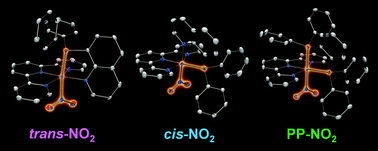Syntheses and properties of phosphine-substituted ruthenium(ii) polypyridine complexes with nitrogen oxides†
Abstract
Four novel phosphine-substituted ruthenium(II) polypyridine complexes with nitrogen oxides—trans(P,NO2)-[Ru(trpy)(Pqn)(NO2)]PF6 (trans-NO2), cis(P,NO2)-[Ru(trpy)(Pqn)(NO2)]PF6 (cis-NO2), [Ru(trpy)(dppbz)(NO2)]PF6 (PP-NO2), and cis(P,NO)-[Ru(trpy)(Pqn)(NO)](PF6)3 (cis-NO)—were synthesised (trpy = 2,2′:6′,2′′-terpyridine, Pqn = 8-(diphenylphosphanyl)quinoline, and dppbz = 1,2-bis(diphenylphosphanyl)benzene). The influence of the number and position of the phosphine group(s) on the electronic structure of these complexes was investigated using single-crystal X-ray structural analysis, UV-vis absorption spectroscopy, and electrochemical measurements. The substitution lability of the nitrogen oxide ligand of each complex is discussed in comparison with that of the corresponding acetonitrile complexes.


 Please wait while we load your content...
Please wait while we load your content...